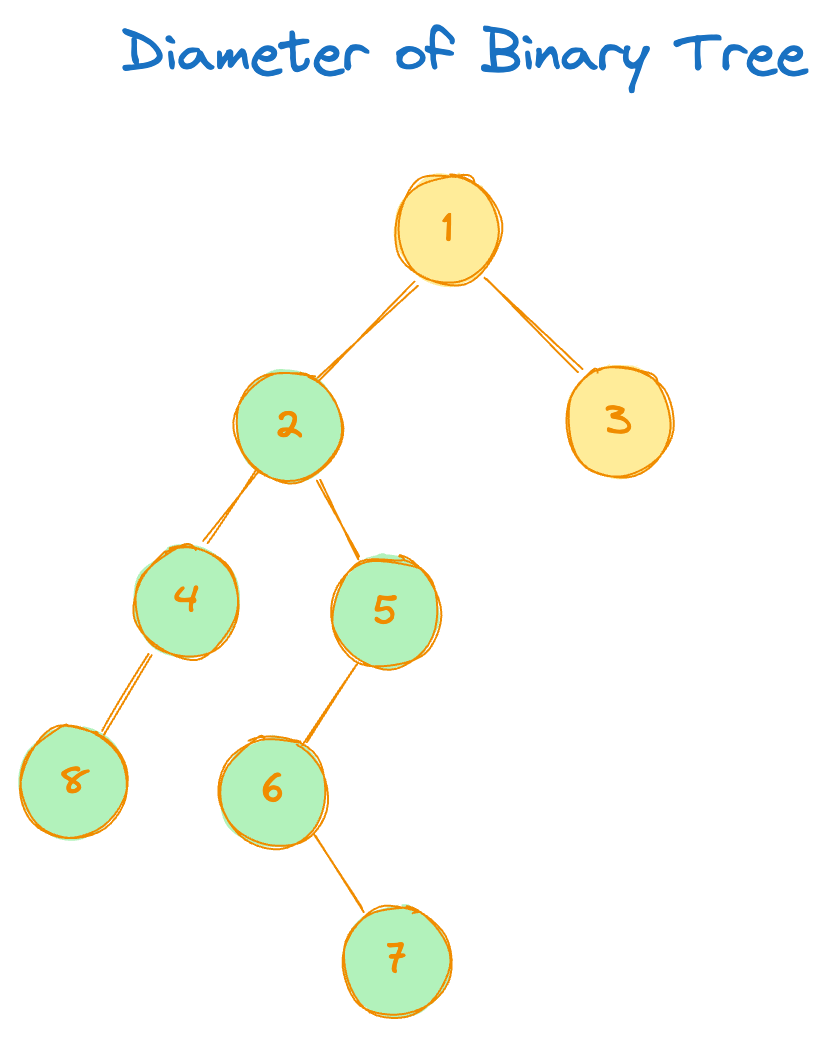Diameter Of a Binary Tree
EasyUpdated: Aug 2, 2025
Practice on:
Problem
Given a binary tree, find the diameter of it.
Definition
Diameter of tree is defined as a longest path or route between any two nodes in a tree. The path may or may not for through the root.
Examples
Example 1:
1
/ \
2 3
/ \
4 5
Input: root = [1,2,3,4,5]
Output: 3
Explanation: 3 is the length of the path [4,2,1,3] or [5,2,1,3].
Example 2:
Input:
root = [1,2,3,4,5,null, null, 8, null, 6, null, null, null, null, 7]
Output: 5
Note that diameter here doesn't include root.

Solution
Method 1 - Naive Approach
The diameter of a binary tree refers to the length of the longest path between any two leaves. This path can:
- Reside entirely within the left subtree.
- Reside entirely within the right subtree.
- Pass through the root node, connecting leaves from both subtrees.
Algorithm
A straightforward approach involves recursively calculating the diameter:
- Find the height of both the left and right subtrees.
- Compute the diameter of the left subtree.
- Compute the diameter of the right subtree.
- Calculate the longest path that passes through the root by adding 1 (for the root itself) to the sum of the left and right subtree heights.
- The diameter is the maximum of these three values.
Read more - [Height of Binary Tree](maximum-depth-of-binary-tree).
Code
Java
public int diameterOfBinaryTree(TreeNode root) {
if (root == null) {
return 0;
}
int leftHeight = maxDepth(root.left);
int rightHeight = maxDepth(root.right);
int leftDiameter = diameter(root.left);
int rightDiameter = diameter(root.right);
return max(leftDiameter, rightDiameter, leftHeight + rightHeight + 1);
}
public int maxDepth(TreeNode root) {
if (root != null) {
return 1 + Math.max(maxDepth(root.left), maxDepth(root.right));
}
return 0;
}
private int max(int a, int b, int c) {
return Math.max(a, Math.max(b, c));
}
Complexity
- Time complexity -
O(N^2). However, this approach suffers from redundancy as it calculates the height of each node multiple times, leading to a time complexity of O(N^2).
Method 2 - Return Height and Diameter in Same Iteration
To optimize the calculation, we can modify the function to compute the height and diameter simultaneously.
Algorithm
- During the recursive traversal, calculate both the height and the maximum diameter encountered so far for each subtree.
- The height returned by a subtree function represents the maximum depth from that subtree's root to a leaf node (including the root).
- The diameter returned by a subtree function represents the maximum diameter found within that subtree or the longest path passing through the subtree's root.
Code
Java
public int diameterOfBinaryTree(TreeNode root) {
if(root == null){
return 0;
}
return getDiameter(root)[0] - 1;
}
private int[] diameterOfBinaryTree(TreeNode root) {
int dAndH[] = { 0, 0 }; // first diameter, second height
int[] leftResult = diameter(root.left);
int[] rightResult = diameter(root.right);
int height = Math.max(leftResult[1], rightResult[1]) + 1;
int leftDiameter = leftResult[0];
int rightDiameter = rightResult[0];
int rootDiameter = leftResult[1] + rightResult[1] + 1;
int finalDiameter = max(leftDiameter, rightDiameter,
rootDiameter);
dAndH[0] = height;
dAndH[1] = finalDiameter;
return DandH;
}
Another way is we pass height as array of 1 element, as Java has pass by value, and return diameter.
public int diameterOfBinaryTree(TreeNode root) {
if(root == null){
return 0;
}
return diameter(root, new int[1]{});
}
private int diameter(TreeNode root, int[] height) {
if (root == null) {
height[0] = 0;
return 0;
}
int[] leftHeight = { 0 }, rightHeight = { 0 };
int leftDiam = diameter(root.left, leftHeight);
int rightDiam = diameter(root.right, rightHeight);
height[0] = Math.max(leftHeight[0], rightHeight[0]) + 1;
return max(leftDiam, rightDiam, leftHeight[0] + rightHeight[0] + 1);
}
Complexity
- Time Complexity -
O(n)